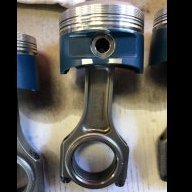Announcements
-
Similar Content
-
Latest Posts
-
Hi All, New member here, I've joined to help my son with an issue that is truly doing our heads in. I'll start with a bit of an overview. Chris carried out some modifications to the engine to try and extract just a little extra power out of the motor and make it a bit more efficient. Previous to this work, the car already had an upgraded exhaust, increased boost up to 14psi, modified standard turbo to metal impellers and slightly oversized, upgraded fuel pump, been dyno-tuned at JEM, and some other bits n bobs like coil packs etc. Before the current mods it was making 236rwkw at 14psi but after the new mods it now makes 209rwkw at 14psi. The work he carried out is as follows, timing belt service, water pump replacement, return to sump radium catch can, had oem head rebuilt and machined 0.2mm, fitted Athena cut ring head gasket 1.2mm thick, arp 2000 head studs, added rear prp head drain, added an external wastegate 40mm turbosmart welded off the stock manifold and plumbed back into a 3in dump. The car has been on the dyno and apparently the ignition is working, fuel flow and fuel pressure is fine, injectors are fine, spark plugs are working fine, Maf is working, O2 sensor is working, TPs sensor is working, VCT is working, CAS is working, boost leak test showed no boost leaks, compression test first crank cold 135psi and got to 150psi across all cylinders once cranking, timing is confirmed at tdc with a dial gauge and the cam dots line up, no blockages in intercoolerm throttle body or pre-turbo intake, no blockages in exhaust, cat conveter or down pipe, turbo looks fine and spins and wastegate looks fine and is new. Soz for all the detail but after all this, it has been in 3 times for dyno and each time comes back stating it's not going to make power. After the first (or second, can't remember now) trip to dyno we did find the timing out by one tooth and this improved things, but it is still well down. Does anyone have any ideas? Any replies much appreciated as we're just not sure of which direction to take this. Regards Rob (Chris's Dad).
-
That's just a gauge, with a certain amount of electronic damping, and no-one cares if it is timely-accurate. I'd hesitate to use it for an ECU MAP input without knowing that it was a nice signal. Responsive but smooth. Not laggy. Not lumpy.
-
Took the dirty BMW to an actual drag meet so I could do a legit full pass on a sticky enough track and had a quiet goal to try and beat my PB in the old R33 GTS25t The time to beat: R33 on stock RB25, Internal gate GT3076R on stock manifold tuned to about 17psi on BP98 and running on drag tyres: F20 M135i with intake, dump pipe and MHD OTS Stage 1 tune on street tyres - didn't even drop the tyre pressure: Kinda similar, and kinda way different
-
By joshuaho96 · Posted
Isn't there a fitting on the back of the balance tube? That's what the OEM boost gauge uses. -
Getting a decent signal from all 6 throats is a challenge. I don't know for sure, but I suspect that the stock balance tube is not ideal for it. I have done it on an ALFA 4 cylinder (about 35 years ago, so don't ask for too many details). We drilled 4x holes in the manifold runners, put in some fittings and ran hoses to a decent sized (I think it was about 20mm diameter) pipe that ran the length of the inlet manifold. So, it was quite a decent volume. There is a "tuning" balance to be found between the volume of the common plenum on such a thing and the diameter of the pipes running from it to the runners. You need the volume to be large enough to damp out the sharp spikes in pressure signal you get as each runner gets sucked on by its cylinder, but not so large that it becomes too slow to respond to actual changes in MAP. And you need the hoses to be small enough to transmit the signal quickly, but not so small that they delay the signal. You might have to have more than one go at it, if there isn't any actual success based wisdom to be had here. Hopefully there is. Anyway, I would not do it on only a couple of cylinders. I would also not care about "permanently modifying a part". Just bloody drill holes and make stuff better. There is nothing sacred about any GTR unless it is a genuine museum piece that you shouldn't be modifying at all anyway.
-




Recommended Posts
Create an account or sign in to comment
You need to be a member in order to leave a comment
Create an account
Sign up for a new account in our community. It's easy!
Register a new accountSign in
Already have an account? Sign in here.
Sign In Now